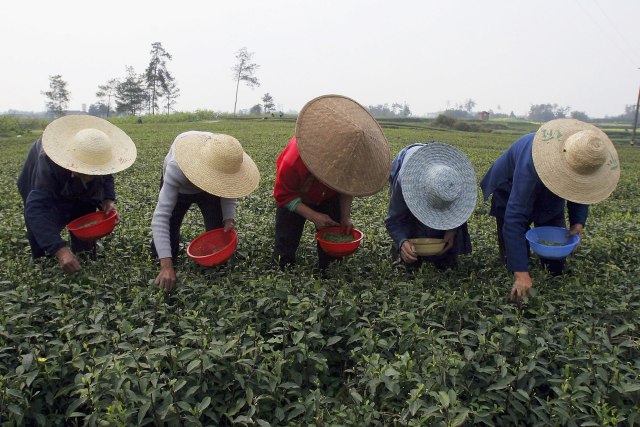Tea picking in China. Credit: China Photos / Getty

Go back a few generations, and chances are your family were farmers. Back-breaking agricultural labour has been the staple of human societies ever since we stopped being hunter-gatherers. And it still is in much of the world. In India, for example, more than one-fifth of the labour force still toil in fields. It’s below 2% now in the US; 1.1% in the UK.
When John and Charles Deere first set up shop in 1837, nearly three-quarters of Americans worked the land. Their company has long dominated the market for agricultural equipment today it’s the largest company of its kind in the world.
Yet in 2018, back-breaking agricultural labour is just about over and Deere’s business model has gone digital. The ancient words of the Biblical curse – “In the sweat of your face shall you eat bread” Genesis 3:19 – no longer apply.
While machines from the plough and the adze onwards have made agriculture more and more efficient, the digital revolution is set to have dramatic effects. After decades of preparation, Deere took the key step for customers in 2012 when it launched MyJohnDeere – an information system to help agricultural producers optimise the management of production data, equipment information and farm operations.
In 1994, it created the Precision Farming Group to look for evolving technologies that could make GPS more accurate and cost effective for providing location information to create yield maps. At that time, no one had proven that GPS could be used for vehicle guidance.
Twenty years later Deere is operating one of the most accurate GPS-based location systems in the world, which lets farmers track their planting, harvesting and more to an accuracy of less than an inch.
And unlike in other areas of the economy – from retail to truck driving – where there is anxiety lest jobs be lost to the robots, in the agricultural sector in developed economies it’s increasingly hard to find that 1-2% still needed to plough and reap. And in both the US and the UK, the need for cheap immigrant farm labour has become entangled with wider immigration concerns.
So while there will be short-term disruption, whether for Mexican labourers in California or the farmers fighting John Deere’s software licensing – if your tractor goes wrong, according to a Draconian Deere licensing arrangement, you can’t fix it yourself, – the core idea that back-breaking agricultural labour will be a thing of the past is wonderful.
Deere’s GPS-controlled tractors are just the tip of the digital iceberg. One report suggests there are already hundreds of thousands of fully-autonomous tractors sold every year. And they are aided by a growing number of specialist robots to carry out all manner of agricultural tasks:
- Using GPS to plant every seed in just the right place. We all know how farmers used to sow – way back, by throwing out handfuls of seed; more recently, they sit on tractors towing a machine around the field that does exactly the same thing. But now: “Autonomous precision seeding combines robotics with geomapping. A map is generated which shows the soil properties (quality, density, etc) at every point in the field. The tractor, with robotic seeding attachment, then places the seeds at precise locations and depths so that each has the best chance of growing.”
- In the same way, both water and fertilizer can be delivered direct to each individual plant but a robot working its way between the rows.
- The same for weeding, and there are options. A robot like AG-BOT II can deliver weedkiller. But it could also target weeds with a laser. Or RoboCrop will hoe the weedy area to destroy them that way.
- The LettuceBot specialises in thinning – deciding which are the weaker plants that need to be removed. Wall-Ye prunes vines.
Meanwhile, the European Commission has been funding efforts to invent specialist harvesting robots since picking soft fruit and other high-value crops is difficult and very labour-intensive. And in California a company called Abundant Robotics has built an apple-picking machine. This is like an enormous vacuum cleaner, but far cleverer:
“The robot’s got to be able to identify an apple, and then after that, tell if it is ripe,” said Dan Swafford, an agricultural technologist at Virginia Tech. “It takes a lot of specialized sensors and cameras to do that, and then they have to be able to pick the fruit without damaging it.”
Strawberries? One Belgian company plans to market its machine in 2019. While humans can pick a strawberry in three seconds, the machine takes five, but they’re working to speed it up.
And it’s not just picking. Cattle ranchers in California and sheep farmers in New Zealand are using drones to round up their stock. In China, they are developing swaps of crop-spraying drones and in Japan, an automated lettuce factory is expected to reduce labour costs by 50%.
True it’s bad news for cowboys. But since the world bank has estimated that we are going to need to produce 50% more food by 2050, given the effects of population and climate change, high-input farming practices are going to have to change. By letting robots take the back-breaking strain, farmers can focus on how to feed the world.










Join the discussion
Join like minded readers that support our journalism by becoming a paid subscriber
To join the discussion in the comments, become a paid subscriber.
Join like minded readers that support our journalism, read unlimited articles and enjoy other subscriber-only benefits.
Subscribe